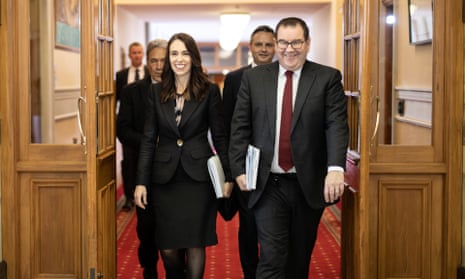With the economic storm of the Covid-19 pandemic raging on, the government has opened the umbrella to shield New Zealand from an even worse economic fate and set the foundation for its recovery. Although the finance minister, Grant Robertson, has accepted that the government can’t save every job, Thursday’s announcements show he is doing everything he can to save as many as possible.
Overall, New Zealand’s 2020 budget was one of the most comprehensive economic packages seen around the world, walking the fine line between responding to the crisis and keeping up economic momentum, while setting down the conditions for recovery and rebuilding.
Front and centre of many policies were jobs – and rightly so, given more than 40,000 Kiwi workers have lost theirs in recent weeks. This focus on jobs – keeping them, training for them, and finding more of them – has seen sizeable investments. A $3.2bn extension of the wage subsidy was a critical policy to stem the tide of unemployment and will keep more Kiwis in work as we approach the more upbeat period of spring. However, businesses will be feeling left out, with cashflow issues still persistent and no substantial support being offered to offset low revenues.
The government has also taken the opportunity to begin addressing other issues, while at the same time boosting employment. The $1.1bn for nature-based jobs is designed to help restore the environment and add 11,000 jobs. Substantial increases to healthcare funding will support work and also build resilience in an area in need of more. Additional state houses will be built, getting a roof over the heads of more vulnerable Kiwis and also keeping local builders paid. And more will be invested in New Zealand’s ageing and underfunded infrastructure, hopefully addressing deficits that have started to threaten safe drinking water and led to faecal contamination of our waterways. More will be needed to fully address these issues completely, but it’s a smart start to support workers and address other issues.
The most impressive announcement from the 2020 budget was the focus on education. The Covid-19 pandemic and resulting economic downturn means that the structure of the economy will change, and our workers will need to change with it. The $1.6bn investment in education and training gives Kiwis who will lose jobs the chance to re-skill themselves for emerging job opportunities, with targeted funding for trades training and apprenticeships giving Kiwis out of a job to prepare for a new career.
The $1.6bn investment in education and training gives Kiwis who will lose jobs the chance to re-skill
Education will be critical moving forward, particularly for New Zealand’s young people. Jobseeker figures from the ministry of social development highlight that job losses have disproportionately hit youth, and the need to provide retraining has never been so important.
Yet there is one glaring omission from the 2020 budget, one that has come about as Robertson has sought to strike a balance between action and adaptability. The budget lacks a solid plan moving forward, which reflects the still uncertain circumstances we find ourselves in. But as the costs of government policies rise, a roadmap for recovery becomes a pressing issue. Businesses are looking to assess where to invest and who to train. Households are looking to find jobs and where to spend. A clear strategy is needed for what a redeveloped New Zealand looks like, including more emphasis placed on digital connectivity and skills, and a renewed focus on our ability to export.
It remains clear is that New Zealand’s economy remains inextricably linked to global fortunes. Our exports are holding up, as the world needs to eat. New Zealand continues to provide a range of high-quality, safe, and premium products to households the world over. Yet as the globe edges into recession, the way we trade has changed too. In focusing on our local economy, New Zealand can’t forget the wider world we operate in and get paid by. Additional investment in exporter support is a good first step.
To achieve all these policies costs money, and the government hasn’t hesitated to write a big cheque to get New Zealand moving. Debt levels will soar, more than doubling to over $200bn. With less money coming in as fewer people are employed, combined with higher unemployment payments and rising support spending, the government will remain in the red for a long time. Taking on debt at times like this is the right, but painful, thing to do. Essentially, New Zealand is spending the pandemic insurance we’ve amassed over recent decades by keeping government debt low.
Going fast and going hard has put New Zealand in the enviable position of being able to reopen the economy without risking lives, and at a faster pace than anywhere else in the world. And to pay for our recovery, we’re essentially taking out another mortgage out against the New Zealand economy. With all this borrowing, and the resulting investment on getting Kiwis back into work, the 2020 budget has set the foundation for economic recovery. But the work doesn’t end here – we need to construct a plan for the future, and ensure that we don’t squander the position we’ve worked so hard to put ourselves in.
Brad Olsen is a senior economist at Infometrics
